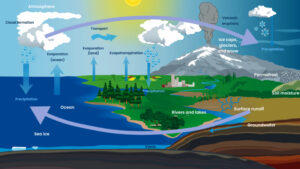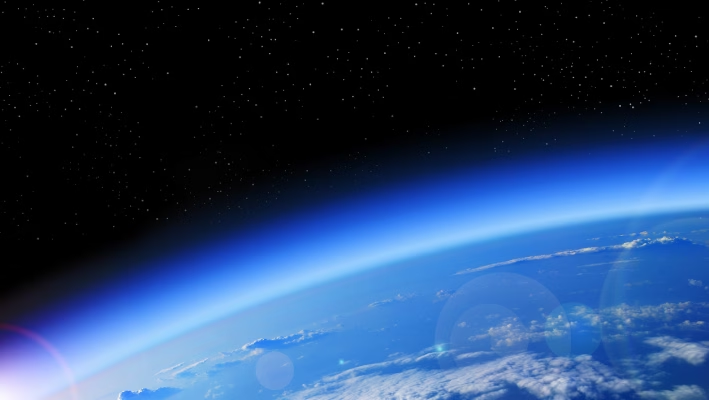Introduction
The atmosphere, a gaseous envelope that envelops our planet, is a marvel of nature that sustains life and shapes the world as we know it. This invisible cloak, extending from the Earth’s surface to hundreds of kilometers above, is a dynamic and complex system, governed by intricate physical and chemical processes.
Understanding the atmosphere is not only a scientific pursuit but also a gateway to unlocking the mysteries of our planet’s past, present, and future.
Composition and Structure
The atmosphere is a heterogeneous mixture of gases, with nitrogen (78%) and oxygen (21%) being the most abundant. However, it is the presence of trace gases, such as carbon dioxide, water vapor, and ozone, that plays a crucial role in regulating the Earth’s climate and supporting life. The atmosphere is vertically divided into several layers, each with its unique characteristics and functions.

The Troposphere
The troposphere is the lowermost layer of the atmosphere, extending from the Earth’s surface to an altitude of approximately 6 to 20 kilometers, depending on latitude and weather conditions. This is the layer where most of the Earth’s weather occurs, including the formation of clouds, precipitation, and atmospheric circulation patterns.
The troposphere is characterized by a decreasing temperature gradient with increasing altitude, a phenomenon known as the environmental lapse rate.
The Stratosphere
Above the troposphere lies the stratosphere, a layer that extends from approximately 10 to 50 kilometers in altitude. This layer is crucial for life on Earth, as it contains the ozone layer, which absorbs harmful ultraviolet radiation from the Sun.
The temperature in the stratosphere increases with altitude due to the absorption of this radiation by ozone molecules, creating a stable environment for weather patterns.
The Mesosphere and Thermosphere
Extending from around 50 to 80 kilometers is the mesosphere, where temperatures decrease with increasing altitude, reaching as low as -100°C (-148°F) at the mesopause, the boundary between the mesosphere and the thermosphere.
The thermosphere, which extends from the mesopause to about 600 kilometers, is characterized by a gradual increase in temperature due to the absorption of high-energy solar radiation by oxygen molecules.
Atmospheric Processes and Phenomena
The atmosphere is a dynamic system governed by various physical and chemical processes that shape our planet’s environment and climate. These processes include atmospheric circulation, the water cycle, the carbon cycle, and the formation of clouds and precipitation.
Atmospheric Circulation
Atmospheric circulation refers to the movement of air masses across the Earth’s surface, driven by the uneven heating of the planet by the Sun. This circulation is responsible for the formation of weather patterns, such as high and low-pressure systems, winds, and temperature variations. \
The Coriolis effect, caused by the Earth’s rotation, plays a crucial role in shaping these circulation patterns, leading to the formation of cyclones and anticyclones. READ ALSO: What is SEO?
The Water Cycle
The water cycle, also known as the hydrologic cycle, is a continuous process that involves the movement of water in its various states (solid, liquid, and gas) through the atmosphere, hydrosphere, and lithosphere. This cycle is driven by the energy from the Sun and is essential for sustaining life on Earth.

The atmosphere plays a crucial role in the water cycle, as it facilitates the evaporation of water from the Earth’s surface and the formation of clouds, which eventually lead to precipitation.
The Carbon Cycle
The carbon cycle is a biogeochemical process that involves the exchange of carbon between the Earth’s atmosphere, biosphere, hydrosphere, and lithosphere. This cycle plays a vital role in regulating the Earth’s climate, as it governs the concentration of greenhouse gases, such as carbon dioxide, in the atmosphere. Human activities, particularly the burning of fossil fuels, have disrupted the natural balance of the carbon cycle, leading to an increase in atmospheric carbon dioxide levels and contributing to global warming.
Cloud Formation and Precipitation
Clouds are formed when water vapor in the atmosphere condenses around microscopic particles called condensation nuclei. The formation and characteristics of clouds are influenced by various factors, including atmospheric temperature, humidity, and air movements. Precipitation, in the form of rain, snow, or other forms, occurs when water droplets or ice crystals within clouds become too heavy to remain suspended in the air.
The Importance of the Atmosphere
The atmosphere is vital for sustaining life on Earth and maintaining a habitable environment. It regulates the planet’s temperature through the greenhouse effect, filters harmful radiation from the Sun, and facilitates the water cycle, which is essential for the existence of life. Furthermore, the atmosphere plays a crucial role in shaping the Earth’s climate and weather patterns, influencing various aspects of human activities and natural processes.
Atmospheric Challenges and Conservation
Despite its importance, the atmosphere faces several challenges, primarily due to human activities. Air pollution, resulting from the emission of pollutants such as particulate matter, nitrogen oxides, and sulfur dioxide, has adverse effects on human health, ecosystems, and the environment.

Climate change, driven by the increasing concentration of greenhouse gases, poses a significant threat to the planet’s delicate balance. Leading to rising temperatures, sea-level rise, and extreme weather events.
Addressing these challenges requires a collaborative effort from individuals, governments, and organizations. Reducing greenhouse gas emissions, promoting sustainable practices, and investing in clean energy technologies. Are crucial steps towards mitigating the impacts of climate change and preserving the atmosphere for future generations.
Conclusion
The atmosphere is a remarkable natural phenomenon that sustains life on Earth. But also shapes our planet’s environment and climate. Its intricate processes and phenomena, from atmospheric circulation to cloud formation. Are a testament to the complexity and beauty of nature. It is our responsibility to protect and preserve this invaluable resource for the sake of our planet and future generations.
References
1. Wallace, J. M., & Hobbs, P. V. (2006). Atmospheric science: An introductory survey (2nd ed.). Academic Press.
2. Hartmann, D. L. (2016). Global physical climatology (2nd ed.). Elsevier.
3. Intergovernmental Panel on Climate Change (IPCC). (2021). Climate Change 2021: The Physical Science Basis.
4. National Oceanic and Atmospheric Administration (NOAA). (n.d.). Air Quality. Retrieved from https://www.noaa.gov/air-quality
5. United States Environmental Protection Agency (EPA). (n.d.). Climate Change. Retrieved from https://www.epa.gov/climate-change

